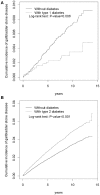Association Between Type I and II Diabetes With Gallbladder Stone Disease
- PMID: 30555418
- PMCID: PMC6281708
- DOI: 10.3389/fendo.2018.00720
Association Between Type I and II Diabetes With Gallbladder Stone Disease
Abstract
Objective: To assess the association of type 1 diabetes (T1DM) and type 2 diabetes (T2DM) with the subsequent development of gallbladder stone disease (GSD). Setting: Cohort Study. Participants: We identified two study cohort groups to evaluate the association of T1DM and T2DM with the development of GSD. The first group comprised a T1DM cohort of 7015 patients aged ≤ 40 years and a non-diabetes cohort randomly matched with the study cohort (4:1). The second group comprised a T2DM cohort of 51,689 patients aged ≥20 years and a non-diabetes cohort randomly matched with the study cohort (1:1). All patients were studied from 1996 to the end of 2011 or withdrawal from the National Health Insurance program to determine the incidence of GSD. Results: Compared with patients without diabetes, those with T1DM had a decreased risk of GSD [adjusted hazard ratios (aHR) = 0.48, 95% confidence interval (CI) = 0.25-0.92]. Those with T2DM had an increased risk of GSD (aHR = 1.55, 95% CI = 1.41-1.69), after adjustment for age, sex, comorbidities, and number of parity. The relative risk of GSD in the T2DM cohort was higher than that in the non-diabetes cohort in each group of age, sex, and patients with or without comorbidity. However, the relative risk of GSD in the T1DM cohort was lower than that in the non-diabetes cohort only in the age group of 20-40 years. Conclusion: Our population-based cohort study reveals a strong association between T2DM and GSD. However, an inverse relationship exists between T1DM and GSD in patients aged 20-40 years.
Keywords: ICD-9 codes; cohort study; gallbladder stone disease; type 1 diabetes; type 2 diabetes.
Figures
Similar articles
-
Gallbladder Stone Disease Is Associated with an Increased Risk of Migraines.J Clin Med. 2018 Nov 21;7(11):455. doi: 10.3390/jcm7110455. J Clin Med. 2018. PMID: 30469346 Free PMC article.
-
Association between gallbladder stone disease and prostate cancer: A nationwide population-based study.Oncotarget. 2016 Sep 27;7(39):64380-64389. doi: 10.18632/oncotarget.9062. Oncotarget. 2016. PMID: 27147576 Free PMC article.
-
Association between Inflammatory Bowel Disease and Cholelithiasis: A Nationwide Population-Based Cohort Study.Int J Environ Res Public Health. 2018 Mar 14;15(3):513. doi: 10.3390/ijerph15030513. Int J Environ Res Public Health. 2018. PMID: 29538289 Free PMC article.
-
Cost of diabetes: comparison of disease-attributable and matched cohort cost estimation methods.Curr Med Res Opin. 2010 Aug;26(8):1827-34. doi: 10.1185/03007995.2010.488544. Curr Med Res Opin. 2010. PMID: 20491613
-
Association between chronic pancreatitis and urolithiasis: A population-based cohort study.PLoS One. 2018 Mar 9;13(3):e0194019. doi: 10.1371/journal.pone.0194019. eCollection 2018. PLoS One. 2018. PMID: 29522553 Free PMC article.
Cited by
-
[New Progress in Longitudinal Research on the Risk Factors for Cholelithiasis].Sichuan Da Xue Xue Bao Yi Xue Ban. 2024 Mar 20;55(2):490-500. doi: 10.12182/20240360508. Sichuan Da Xue Xue Bao Yi Xue Ban. 2024. PMID: 38645861 Free PMC article. Review. Chinese.
-
Association of non-high-density lipoprotein cholesterol to high-density lipoprotein cholesterol ratio (NHHR) and gallstones among US adults aged ≤ 50 years: a cross-sectional study from NHANES 2017-2020.Lipids Health Dis. 2024 Aug 22;23(1):265. doi: 10.1186/s12944-024-02262-2. Lipids Health Dis. 2024. PMID: 39175030 Free PMC article.
-
Association Between Metabolic Dysfunction and Gallstone Disease in U.S. Adults: An Analysis of the National Health and Nutrition Examination Survey.J Dig Dis. 2025 Mar-Apr;26(3-4):158-169. doi: 10.1111/1751-2980.13349. Epub 2025 May 27. J Dig Dis. 2025. PMID: 40420773 Free PMC article.
-
Association between triglyceride-glucose index and gallstones: a cross-sectional study.Sci Rep. 2024 Aug 1;14(1):17778. doi: 10.1038/s41598-024-68841-6. Sci Rep. 2024. PMID: 39090272 Free PMC article.
-
Gallstone Ileus Decades after Cholecystectomy and Pylorus-Preserving Whipples.Case Rep Surg. 2020 Nov 27;2020:8866254. doi: 10.1155/2020/8866254. eCollection 2020. Case Rep Surg. 2020. PMID: 33294247 Free PMC article.
References
LinkOut - more resources
Full Text Sources



